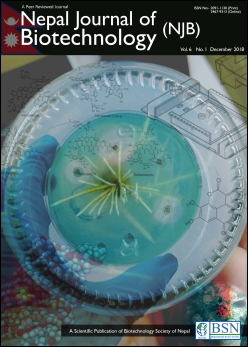Comparative Study of Growth Statistics of Two Species of Paulownia and Optimization of Rooting Methods
DOI:
https://doi.org/10.3126/njb.v6i1.22330Keywords:
Paulownia tomentosa, Paulownia fortuneii, growth comparison, in-vitro rooting, sand-rooting, nodal cultureAbstract
Paulownia is a fast-growing woody tree, native to the forests of China. It belongs to the family Scrophulariaceae and is mainly used as a source of wood for furniture and musical instruments. Due to its fast-growing nature and high-quality of wood, there has been growing interest in cultivation and research of Paulownia in Nepal. Growth comparison was performed by measuring shoot length in in vitro condition. Among two species of Paulownia - Paulownia tomentosa (Thunb.) Steud and Paulownia fortuneii (Seem.) Hemsl., the growth rate of P. tomentosa was found to be 0.355 cm/week while that of P. fortuneii was found to be 0.637 cm/week in in-vitro conditions in MS medium supplemented with 0.1 mg/l NAA and 1mg/l BAP. Optimization of rooting methods was also performed, in which, sand rooting was found to be easier and more effective than in-vitro rooting. Dipping the plantlets in 1 mg/l of NAA was found to produce longer and denser roots than lower or higher concentrations during sand rooting.
Downloads
Downloads
Published
How to Cite
Issue
Section
License
Copyright Notice:
The manuscript submitted to NJB must be an original contribution, not previously published and should not be under consideration for publication elsewhere. When the manuscript is accepted for publication, the authors agree to automatically transfer the copyright of the article to the publisher. It should grant permission to any third party, in advance and in perpetuity, the right to use, reproduce or disseminate your article, according to the NJB copyright and license agreement.
Authors transfer copyright to the publisher as part of a journal publishing agreement but have the rights to: Share their article for Personal Use, Internal Institutional Use and Scholarly Sharing purposes, with the NJB applies the Creative Commons Attribution-NonCommercial CC BY-NC license to all the works we publish after Jun 2020 (Before it was CC BY-NC-ND). Under this license, authors agree to make articles legally available for reuse, without permission or fees, for virtually any non-commercial purpose. Anyone may remix, adapt, and build upon your work non-commercially, and although their new works must also acknowledge you and be non-commercial, they don’t have to license their derivative works on the same terms. More details on CC BY-NC refer to its Licence Deed and Legal Code.






